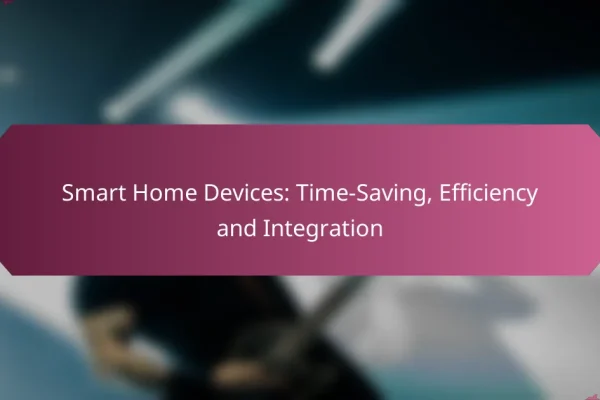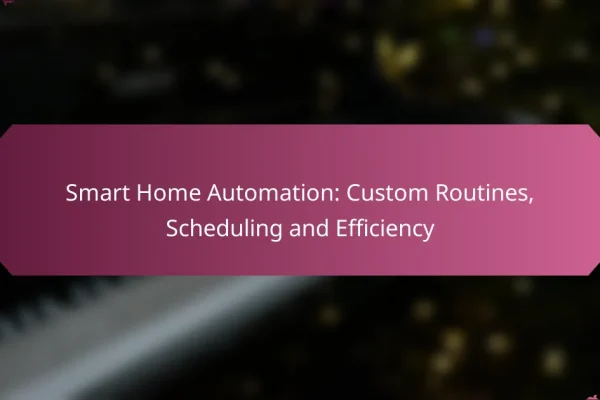How do smart home devices enhance convenience in homes?
Smart home devices significantly enhance convenience by automating everyday tasks, allowing users to control various aspects of their homes remotely. This technology streamlines activities such as lighting, temperature regulation, and security, making home management simpler and more efficient.
Automated lighting systems
Automated lighting systems allow homeowners to control lights through schedules, sensors, or smartphone applications. These systems can adjust brightness based on the time of day or occupancy, reducing energy consumption and enhancing safety.
For example, smart bulbs can be programmed to turn on at sunset or when someone enters a room. Additionally, many systems are compatible with voice assistants, enabling hands-free control.
Smart thermostats
Smart thermostats optimize heating and cooling by learning user preferences and adjusting settings accordingly. They can be controlled remotely via apps, allowing homeowners to manage their home’s climate from anywhere.
Many models offer energy-saving features, such as scheduling and geofencing, which adjusts the temperature based on whether anyone is home. This can lead to significant savings on energy bills, often reducing costs by 10-20%.
Voice-controlled assistants
Voice-controlled assistants, such as Amazon Alexa or Google Assistant, provide hands-free operation for various smart devices. Users can issue commands to control lighting, temperature, and even appliances, making daily tasks more manageable.
These assistants can also integrate with other smart home devices, enabling routines that automate multiple actions with a single voice command, like turning off all lights and locking doors at bedtime.
Remote security monitoring
Remote security monitoring systems allow homeowners to keep an eye on their property through cameras and sensors that can be accessed via smartphones. These systems often include features like motion detection and alerts, enhancing home security.
Many security cameras offer live streaming and recording capabilities, which can be crucial for monitoring activities around the home. Some systems also integrate with smart locks and alarms, providing comprehensive security solutions that can be managed remotely.
What are the best smart home devices for control options?
The best smart home devices for control options include voice assistants and smart devices that integrate seamlessly into your home. These devices enhance convenience by allowing you to manage various aspects of your home environment through voice commands or mobile apps.
Amazon Echo
The Amazon Echo is a versatile smart speaker that uses the Alexa voice assistant to control smart home devices. You can use it to adjust lighting, play music, set reminders, and even control your thermostat, all through simple voice commands.
Consider the Echo’s compatibility with a wide range of smart home products, making it a central hub for your smart home ecosystem. Ensure your devices are compatible with Alexa for optimal performance.
Google Nest Hub
The Google Nest Hub combines a smart display with Google Assistant, allowing for both voice and touch control of your smart home devices. You can view security camera feeds, control lights, and manage your calendar all in one place.
This device is particularly useful for visual tasks, such as following recipes or watching videos while you cook. Its integration with Google services enhances functionality, making it a great choice for those already using Google products.
Philips Hue lights
Philips Hue lights offer smart lighting solutions that can be controlled via voice or app. You can customize colors, brightness, and schedules, creating the perfect ambiance for any occasion.
These lights are compatible with both Amazon Alexa and Google Assistant, allowing for seamless integration into your existing smart home setup. Consider starting with a starter kit that includes a hub and a few bulbs to explore the possibilities.
August Smart Lock
The August Smart Lock allows you to control your door lock remotely using a smartphone app. You can lock or unlock your door from anywhere, making it convenient for guests or deliveries.
This smart lock is compatible with both Amazon Alexa and Google Assistant, enabling voice control. Ensure you have a reliable Wi-Fi connection for optimal performance and consider setting up temporary access codes for visitors.
How do smart home devices improve energy efficiency?
Smart home devices enhance energy efficiency by automating and optimizing energy use in households. They allow users to monitor consumption, schedule operations, and control devices remotely, leading to reduced waste and lower utility bills.
Smart plugs
Smart plugs enable users to control electrical devices remotely, turning them on or off via a smartphone app. This functionality helps prevent energy waste by ensuring that devices are not left on unnecessarily. For example, you can schedule your coffee maker to turn off after brewing, saving power during the day.
When selecting smart plugs, look for those with energy monitoring features that provide insights into usage patterns. This data can help identify devices that consume excessive energy, allowing for informed decisions on usage or replacement.
Energy monitoring systems
Energy monitoring systems track overall energy consumption in real-time, providing detailed insights into which appliances use the most power. These systems can be integrated with smart home networks to automate responses, such as reducing power to high-consumption devices during peak hours.
Consider systems that offer alerts for unusual spikes in energy use, which can indicate malfunctioning devices. Many energy monitoring systems are compatible with renewable energy sources, allowing for better management of solar or wind energy usage.
Smart appliances
Smart appliances, such as refrigerators, washing machines, and thermostats, are designed to optimize energy use through advanced features. For instance, smart thermostats can learn your schedule and adjust heating or cooling accordingly, potentially reducing energy bills by 10-20%.
When investing in smart appliances, look for ENERGY STAR ratings, which indicate higher efficiency. Additionally, consider appliances that can be controlled remotely, enabling you to operate them during off-peak hours when energy rates are lower.
What factors should you consider when choosing smart home devices?
When selecting smart home devices, consider compatibility with your existing systems, ease of installation, and brand reliability. These factors will significantly influence your overall experience and satisfaction with the technology.
Compatibility with existing systems
Ensure that the smart home devices you choose are compatible with your current systems, such as your Wi-Fi network, smart assistants, and other connected devices. For example, devices that work with Amazon Alexa or Google Assistant can provide seamless integration and control.
Check for compatibility with common protocols like Zigbee or Z-Wave, which allow devices from different manufacturers to communicate. This can enhance your smart home ecosystem and prevent you from being locked into a single brand.
Ease of installation
Consider how easy it is to install the smart home devices. Many products are designed for quick setup, often requiring just a smartphone app and a few simple steps. Look for devices that offer clear instructions and minimal wiring for a hassle-free installation.
Some devices may require professional installation, which can add to the overall cost. Assess whether you are comfortable with DIY installation or if you prefer to hire a professional to ensure everything is set up correctly.
Brand reliability
Choose devices from reputable brands known for their reliability and customer support. Research user reviews and ratings to gauge the performance and durability of the products you are considering.
Brands with a strong track record often provide regular software updates and security patches, which are crucial for maintaining the functionality and safety of your smart home devices. Avoid lesser-known brands that may not offer the same level of support or quality assurance.
What are the top brands for smart home devices?
The leading brands for smart home devices include Apple HomeKit, Samsung SmartThings, and Ring. Each brand offers unique features and compatibility options that cater to different user needs and preferences.
Apple HomeKit
Apple HomeKit is designed for users who prefer a seamless integration with their Apple devices. It allows you to control various smart home products through the Home app on iOS devices, providing a user-friendly interface.
HomeKit supports a wide range of devices, including lights, locks, and thermostats, all of which can be managed using Siri for voice control. Ensure that the devices you choose are HomeKit-compatible to take full advantage of its features.
Samsung SmartThings
Samsung SmartThings offers a versatile platform that connects a variety of smart devices from different manufacturers. It allows users to create custom automations and routines, enhancing the convenience of managing their smart home.
This platform supports both Zigbee and Z-Wave protocols, making it compatible with a broader range of devices. Users should consider the initial setup and potential need for a SmartThings Hub to connect devices effectively.
Ring
Ring is primarily known for its security-focused smart home devices, including video doorbells and security cameras. It provides real-time notifications and video feeds, allowing users to monitor their homes remotely.
Ring devices can be integrated with other smart home systems, but they excel in standalone security solutions. Users should evaluate subscription options for cloud storage and additional features to maximize their security setup.
How do smart home devices integrate with home security?
Smart home devices enhance home security by connecting various systems, such as cameras, alarms, and locks, allowing for centralized control and monitoring. This integration provides homeowners with real-time alerts and remote access to their security systems, improving overall safety.
Types of smart home security devices
Common types of smart home security devices include smart cameras, smart doorbells, smart locks, and motion sensors. Smart cameras can provide live feeds and recordings, while smart doorbells allow homeowners to see and communicate with visitors remotely. Smart locks enable keyless entry and can be controlled via smartphone apps.
Benefits of integration
Integrating smart home devices with security systems offers several advantages, including enhanced convenience and improved response times. Homeowners can receive instant notifications on their smartphones if a security breach occurs, allowing for quicker action. Additionally, many systems allow for automation, such as setting lights to turn on when motion is detected.
Considerations for setup
When setting up smart home security devices, consider compatibility with existing systems and the strength of your Wi-Fi network. Ensure that devices can communicate effectively with each other and that your network can handle the additional load. It’s also wise to set strong passwords and enable two-factor authentication to protect against unauthorized access.
Common pitfalls
One common pitfall is neglecting regular updates for your smart devices, which can leave them vulnerable to security threats. Another issue is failing to customize alert settings, leading to notification overload or missing critical alerts. Always review your device settings and adjust them based on your security needs.









